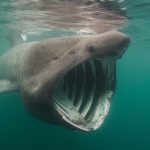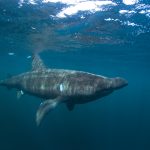Background
The second biggest fish in the world; the Basking Shark gets its name from it tendency to be found near the water’s surface where it appears to ‘bask’ in the sun. It has a dull-greyish colour areas of blotchy skin spread across the surface of the animal.
Habitat
It is a migratory species that is able to live thousands of miles from shore in the open areas of the sea. Depending on the availability of prey it can be found at the water’s surface or as deep as 900 meters.
Diet
Their diet consists exclusively of plankton. Within the plankton, they prefer tiny organisms such as animal larvae rather than the microscopic algae.
Predators & Threats
Being so large they have no natural predators with the rare exception of Great White Sharks and Killer Whales, however they are listed as vulnerable due to being overfished. Whilst the sale of any Basking Shark products has been illegal in Europe since 2007, it is thought they are still caught in small numbers throughout the Atlantic Ocean.
Facts
- Of approximately 400 species of sharks, the Basking Shark is one of only three species that feeds off plankton.
- It takes up to three years for young to develop inside the female, before being ready for birth.
| Common Name(s) | Scientific Name |
| Basking Shark | Cetorhinus maximus |
| Size | |
| Up to 9 meters in length | |
| Lifespan | |
| 40+ years | |
Best Time to Look
It is a seasonal shark, being found between May and October off the coasts of Southeast England and around Scotland.




